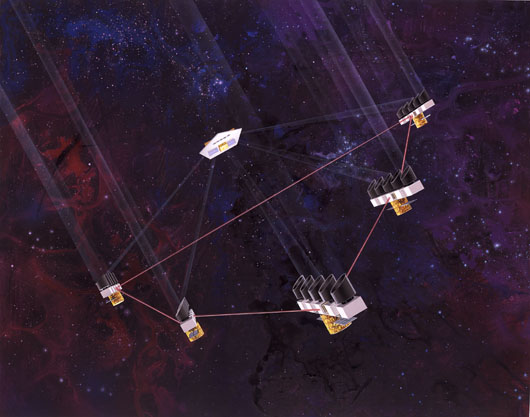Spacecraft Formation Flying Navigation
From ANCS Wiki
Research is being performed for vision-based attitude and position determination for formation flying applications using a newly-developed sensor by Dr. John L. Junkins employing Position Sensing Diodes to determine line-of-sight vectors to optical beacons.
The vision-based navigation (VISNAV) system comprises of an optical sensor of a new kind combined with specific light sources (beacons) in order to achieve a selective or "intelligent" vision. The sensor is made up of a Position Sensing Diode (PSD) placed in the focal plane of a wide angle lens. When the rectangular silicon area of the PSD is illuminated by energy from a beacon focused by the lens, it generates electrical currents in four directions that can be processed with appropriate electronic equipment. While the individual currents depend on the intensity of the light, their imbalances are weakly dependent on the intensity and are almost linearly proportional to the location of the centroid of the light beam in the PSD.
Spacecraft formation flying is an evolving technology with many possible applications, such as long baseline interferometry, stereographic imaging, synthetic apertures, and distinguishing spatial from temporal magnetospheric variations. A significant advantage of distributed spacecraft platforms over a single multifunctional spacecraft is that single point failures can be rectified through replacement of cheaper and smaller spacecraft to maintain mission capability, thus providing a more reliable and robust system. Many missions (in particular interferometry missions) rely on precise relative position and attitude knowledge in order to maintain mission requirements. To date, most research studies into determining relative positions and attitudes between vehicles have involved using the Global Positioning System (GPS), which restricts the spacecraft formation to near-Earth applications. An application of GPS-like technology to a deep space mission has been proposed, but this requires extensive hardware development and is subject to the generic GPS performance-limiting effects, including multipath, geometric dilution of precision, integer ambiguity resolution, and cycle slip. The main objective of the proposed research is to provide a novel, reliable, and autonomous relative navigation and attitude determination system, employing relatively simple electronic circuits with modest digital signal processing (DSP) requirements, and being fully independent of any external systems.
This work is sponsored by NASA-Goddard Space Flight Center. Results from research can be obtained from:
[1] Andrle, M.S., Hyun, B., Crassidis, J.L., and Linares, R., “Deterministic Relative Attitude Determination of Formation Flying Spacecraft,” AIAA/AAS Astrodynamics Specialist Conference, Honolulu, HI, Aug. 2008, AIAA Paper #2008-6934.
[2] Kim, S.-G., Crassidis, J.L., Cheng, Y., Fosbury, A.M., and Junkins, J.L., “Kalman Filtering for Relative Spacecraft Attitude and Position Estimation,” AIAA Journal of Guidance, Control, and Dynamics, Vol. 30, No. 1, Jan.-Feb. 2007, pp. 133-143.
[3] Banas, W.D., and Crassidis, J.L., “Micro-Arcsecond Line-of-Sight Filtered Performance for Spacecraft Formation Flying Paper Number,” AIAA/AAS Astrodynamics Specialist Conference, Keystone, CO, Aug. 2006, AIAA Paper #2006-6530.
[4] Kim, S.-G., Crassidis, J.L., Cheng, Y., Fosbury, A.M., and Junkins, J.L., “Kalman Filtering for Relative Spacecraft Attitude and Position Estimation,” AIAA Guidance, Navigation, and Control Conference, San Francisco, CA, Aug. 2005, AIAA Paper #2005-6087.
[5] Kappagantula, K., and Crassidis, J.L., “Linearizing Assumptions and Control Design for Spacecraft Formation Flying Maneuvers,” 18th International Symposium on Space Flight Dynamics, Munich, Germany, Oct. 2004, ESA SP-548.
[6] Yim, J.R., Crassidis, J.L., and Junkins, J.L., “Autonomous Orbit Navigation of Two Spacecraft System Using Relative Line of Sight Vector Measurements,” AAS Space Flight Mechanics Meeting, Maui, HI, Feb. 2004, AAS Paper #04-257.
[7] Sun, D., and Crassidis, J.L., “Observability Analysis of Six Degree of Freedom State Determination Using Vector Observations,” AIAA Journal of Guidance, Control, and Dynamics, Vol. 25, No. 6, Nov.-Dec. 2002, pp. 1149-1157.
[8] Alonso, R., Du, J.-Y., Hughes, D., Junkins, J.L., and Crassidis, J.L., “Relative Navigation for Formation Flying of Spacecraft,” Proceedings of the Flight Mechanics Symposium, NASA-Goddard Space Flight Center, Greenbelt, MD, June 2001, pp. 115-129.
[9] Crassidis, J.L., Alonso, R., and Junkins, J.L., “Optimal Attitude and Position Determination from Line-of-Sight Measurements,” The Journal of the Astronautical Sciences, Vol. 48, Nos. 2-3, April-Sept. 2000, pp. 391-408.
[10] Yim, J.R., Crassidis, J.L., and Junkins, J.L., “Autonomous Orbit Navigation of Interplanetary Spacecraft,” AIAA Guidance, Navigation, and Control Conference, Denver, CO, Aug. 2000, AIAA Paper #00-3936.
[11] Alonso, R., Crassidis, J.L., and Junkins, J.L., “Vision-Based Relative Navigation for Formation Flying of Spacecraft,” AIAA Guidance, Navigation, and Control Conference, Denver, CO, Aug. 2000, AIAA Paper #00-4439.


